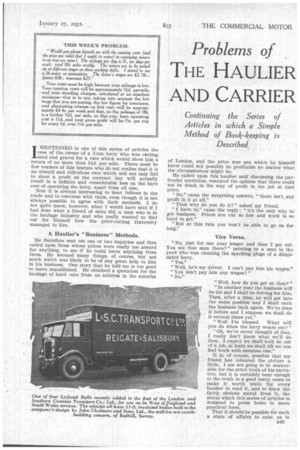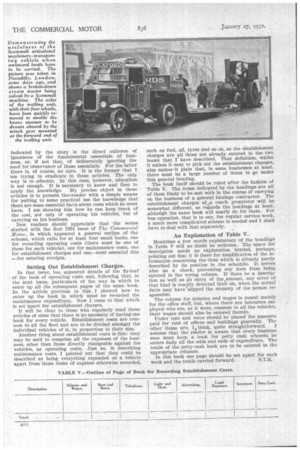Problems of
Page 61

Page 62

If you've noticed an error in this article please click here to report it so we can fix it.
THE HAULIER
AND CARRIER
Continuing the Series of Articles in which a Simple Method of Book-keeping is Described,
IMENTIONED in one of this series of articles the ease of the owner of a 5-ton lorry who was carting sand and gravel for a rate which would show him a return of no more than 53d. per mile. There must be few readers of this feature who do not realise that it is an absurd and ridiculous rate which will not only fail to show a profit on the contract but will actually result in a definite and considerable loss on the bare
cost of operating the lorry, apart from all else. '
Now it is always interesting to meet fellows in the trade and to converse with them, even though it is not always possible to agree with their methods. I do not quite know, however, what I would have said if I had done what a friend of mine did, a man who is in the haulage industry and who really wantedto find out for himself how the price-cutting fraternity managed to live.
A Haulier's "Business" Methods.
He therefore sent out one or two inquiries and then called upon those whose prices were really too absurd for anything, to see if he could learn anything from them. He learned many things, of course, but not much which was likely to be of any great help to him in his business. One story that he told me is too good to leave unpublished. He obtained a quotation for the haulage of hard core from an address in the suburbs of London, and the price was qne which he himself knew could not possibly be profitable no matter what the circumstances might be.
Re called upon this haulier and! discussing the particular quotation, ventured the opinion that there could not be much in the way of profit in the job at that price.
"No," came the surprising answer, "there isn't any profit in it at all."
"Then why do you do it?" asked my friend.
"I have to," came the reply ; "it's the only way to get business. Prices are cut so low and work is so hard to get."
"But at this rate you won't be able •to go on for long."
Vice Versa.
"No, just for one year longer and then I get out. You see that man there?" pointing to a man in the yard who was cleaning the sparking plugs of a dilapidated lorry.
"Well, he's my driver. I can't pay him his wages."
"You don't pay him any wages?" t‘ No?, "Well, how do you get on then?" "In another year the business will • he his and I shall be driving for him. Then, after a time, he will get into . the same position and I shall earn the business back again. We've done it before and I suppose we shall do it several times yet."
" Well I'm blessed. What will you do when the lorry wears out?"
"Oh, we've never thought of that. I really don't know what we'll do then. I expect we shall both be out of a job, at least we shall till we can find work with someone else."
It is, of course, possible that my friend has coloured the picture a little. I am not going to be answerable for the strict truth of his narrative, but it is certainly near enough to the truth in a good many cases to make it worth while for every haulier to read it, and to draw the fairly obvious moral from It, the moral which this series of articles is designed to press home in more practical form.
That it should be possible for such a state of affairs to exist as is E•43,
indicated by the story is the direct outcome of ignorance of the fundamental essentials of business, or, if not that, of deliberately ignoring the need for observance of those essentials. For the latter there is, of course, no cure. It is the former that I am trying to eradicate in these articles. The only way is to educate. In this case, however, education is not enough. It is necessary to know and then to apply the knowledge. My precise object in these articles is to present theAreader with a simple means for putting to some practical use the knowledge that there are some essential facts about costs which be must have. I am showing him how he can keep track of the cost, not only of operating his vehicles, but of carrying on his business. New readers should appreciate that the series started with the first 1931 issue of The Commercial Motor, in which appeared a general outline of the scheme, which calls for at least four small books, one for recording operating costs (there must be one of these for each vehicle), one for maintenance costs, one for establishment charges and one—most essential this --for entering receipts.
Setting Out Establishment Charges.
In that issue, too, appeared details of the fly-leaf of the book of operating costs and, following that, in the next issue, particulars of the way in which to enter up all the subsequent pages of the same book. In the article previous to this I showed how to enter up the book in which must be recorded the maintenance expenditure. Now I come to that which is set apart for establishment charges. It will be clear to those who regularly read these articles of mine that there is no necessity of having one book for every vehicle. Establishment costs are common to all the fleet and are to be divided amongst the individual vehicles of it, in proportion to their size. Another thing about establishment costs is this: they may be said to comprise all the expenses of the business, other than those directly chargeable against the vehicles, as operating costs. Just as, in describing maintenance costs, I pointed out that they could be described as being everything expended on a vehicle apart from those items of expense otherwise recorded, such as fuel, oil, tyres and so on, so the eitablishment charges are all those not already entered in the two books that r have described. That definition, whilst it makes it easy to pick out the establishment charges. also makefevit plain that, in some businesses at least, there must be a large number of items to go under this general heading. The book itself should be ruled after the fashion of Table V. The items indicated by the headings are all of them likely to be met with in the course of carrying on the business of a general haulage contractor. The establishment charges of 4a coach proprietor will be somewhat different, as regards the headings at least, althofigh the same book will nearly do for them. For bus operation, that is to say, for regular service work, a much more complicated scheme is needed and I shall have to deal with that separately.
An Explanation of Table V.
Meantime a few words explanatory of the headings in Table V will no doubt be welcome. The space for description needs no explanation beyond, perhaps, pointing out that it is there for amplification of the information concerning the .item which is already partly described by its position in the schedule. It serves also as a check, preventing any item from being entered in the wrong column. If there be a description as well as In entry of the amount, any error of that kind is readily detected later on, when the actual facts may haveslipped the memory of the person responsible. The column for salaries and wages is meant mainly for the office staff, but, where there are labourers employed who are, as it were, common to all the vehicles, their wages should also be entered therein. Under rent and rates should be placed the amounts paid for rent of offices and buildings generally. The other items are, II think, quite straightforward. I assume that the reader is aware that every business man must keep a book for petty cash wherein he enters daily all the odds and ends of expenditure. The totals of the petty-cash book are to be entered in the appropriate columns. In this book one page should be set apart for each week and the totals carried forward. S.T.R.




































































































